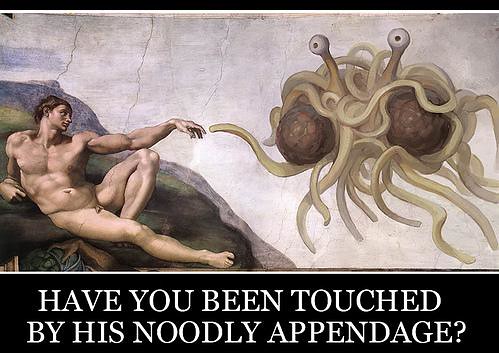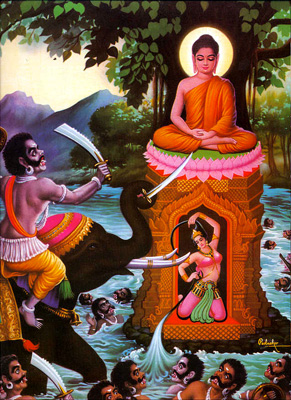--His Holiness the 14th Dalai Lama

Fig. 1 Dharma punk
There are as many slight variations to the Buddha’s life story and initial enlightenment as there are schools of thought, and technically, since there are as many schools of thought as there are people who perceive them, and all can be considered equally valid, I’ll equally do no justice to all except one: Mine.
Siddartha Gautama was born into a ruling Hindu family in India around the fifth century BCE. His mother Mahamaya had a dream that a white elephant entered her womb through a slit in her right side. Everyone she told about this dream flipped out, saying the kid was either going to be a super awesome king or an enlightened being. While she was pregnant, she was traveling to her parents’ home and gave birth along the way, popping out a perfectly clean baby who started walking only moments later with flowers blooming under each footstep he took while devas(minor gods) sang his praises… until they had to change his first diaper.
Sid grew up with all the lavish comforts of a great prince and was completely sheltered from the outside world right up until his adulthood. His father made sure Sid never saw anyone grow old, get sick or die. Sid grew up, got married, had a kid, and one day decided to cruise around the kingdom outside the palace walls in his chariot, to you know, survey all that would be his one day… other than the curtains. I imagine the historic event of “The Four Sights” unfolded not unlike an episode of Jeeves and Wooster.

Fig. 1 Hugh & Stephen are enlightened beings
Chandaka, the long-suffering and worldly valet, calmly answered with a polite British accent, “That would be an old man, Sir.”
Sid cringed at the man’s wrinkles and sluggish pace, saying, “Is that normal?”
Chandaka said, “Yes, Sir. All people grow old.”
Next, Sid pointed at a dude face down in the gutter, covered in oozing sores. “Ugh! Who’s that?”
“That’s a sick man, Sir.”
Sid shook his head in disgust. “What’s that all about?”
Chandaka said, “All people get sick from disease, Sir.”
Sid pointed at a corpse on the ground and Chandaka rolled his eyes.
“That’s a dead person, Sir. People tend to die.”
“Ewwww,” Sid said. Then he saw a guy in robes sitting under a tree. “And what about him?”
“That’s an ascetic, Sir. They take a vow of poverty and walk from village to village meditating and learning sacred scripture.”
“Oh, that’s not so bad,” Sid said, scratching his chin. He held up a finger and said, “Maybe I’ll give it a try.”
“Your father won’t be very chuffed, Sir.”
“Forget him!” Sid blurted. “I’m doing it!”
That very night, Sid kissed his sleeping wife and son goodbye and set off into the forest, shedding his royal robes and donning dodgy rags. For six years he wandered around, picking up some flunkies along the way. They all tramped around, eating things no more nutritious than Altoids and enduring the harshest conditions. It was said that Sid once meditated in a circle of fire in the middle of summer, bringing new meaning to the phrase “schvitzing your toochis off.”
Though he was a Hindu who believed in the Hindu pantheon, the enlightened Buddha never really talked about God or gods in general. As far as he was concerned, the Supreme Whatever couldn’t free humans from suffering to save the world(literally), and no compendium of creation stories or polytheistic parables was going to help. Sid made it his mission to find out how to stop suffering if it killed him, and it almost did.
Sid came so close to death from starvation that he realized that he wasn’t a fan of dying, so he resolved to give his body the necessary sustenance it needed for the sake of finding the Truth. He ate one grain of rice and his mendicant buddies said, “Awe, forget you, man. You fell off the wagon. We’re outta here.”
Dissed and abandoned, Sid sat under a tree and meditated for a long time. When he was on the verge of enlightenment, Mara (the deva of wordly temptation) arrived with his armies to try and seduce Sid into staying in samsara, this imperfect human realm of existence.
“Come on, man, you know you wanna make love to my hordes of sexy ladies for all time,” Mara said.
Sid just sat and shook his head. “What’s the point? They’ll all be dead someday.”
“Oh yeah, well my attacking elephants will change your mind!”
Sid just smiled and touched the earth, calling up the earth goddess as witness to his hundreds of past lifetimes filled with good deeds.
Sid smiled and said to the earth, “Hey, baby, show Mara how cool I am.”
The goddess then happily wrung out her long hair, which was soaked with the water of Sid’s meritorious actions, and washed away all Mara’s armies.
Fig. 2 Boo-yah!
Upon his rejection of Mara and further meditation for three more nights, Sid became the bodhisattva formerly known as Siddartha Gautama and awakened as The Buddha—“enlightened one.” The ten thousand world systems shook, he saw all his past lives, he saw everyone else’s and their brothers’ past lives, and he gained the knowledge of the causally conditioned workings of reality. It’s like getting a One Million-Up in Donkey Kong. Plus omniscience.
But there was no Game Over screen. Buddha was enlightened, and he escaped the cycle of re-birth, but he was still dwelling in this world.
So what was next for the Big B?
Spread the word.
The first thing he did was track down his old peeps. They were all sitting around, thinking to themselves, “We’ll show him to eat rice. We’ll just sit here and ignore him as he swaggers by.” As the Buddha approached, they couldn’t resist the plainly apparent aura of love and compassion emanating from him.
“Hey man, what’s up?” one said.
The Buddha held up his hand and said, “My friend, call me the Tathagata (one who has gone onto the path of enlightenment).”

Fig. 3 Peeps in the park
He sat down and rapped with them, conducting the “first turning of the Dharma wheel” right there in Deer Park, not far from Varanasi. He told everyone the Four Noble Truths and the Eightfold Path and continued to travel India for a 45-year tour before he merged with the infinite and finally attained nirvana. The Dhammapada, The Buddha’s Greatest Hits, sold like hot chapatiya bread.
No one has to believe this story is true to benefit from the Buddha’s teachings. I love the story, especially the part about the earth being witness to all deeds. It’s the Pagan within me. Yes, it’s a fantastic story full of faith-testing elements of miracles and moral themes, but I’m not going to be punished in some unfathomably scorching piece of real estate for not insisting it’s the absolute truth. I don’t feel an ounce of cosmic guilt for what I believe or don’t believe about dinosaurs or evolution or intelligent design.
The Buddha couldn’t care less what I believe. I could believe in Jesus, Vishnu, Allah, or the Flying Spaghetti Monster and the Buddha would say, “If the sandal fits.” I’m leaning toward the pasta, by the way. It’s the Italian in me. The Gospel of the FSM is very mouth-watering.

Fig. 4 Yes, I have








No comments:
Post a Comment
You're welcome to comment. Just keep in mind this is a personal as well as an academic blog and I like to see thoughtful, respectful commentary. No offensive language or curt replies, please :)